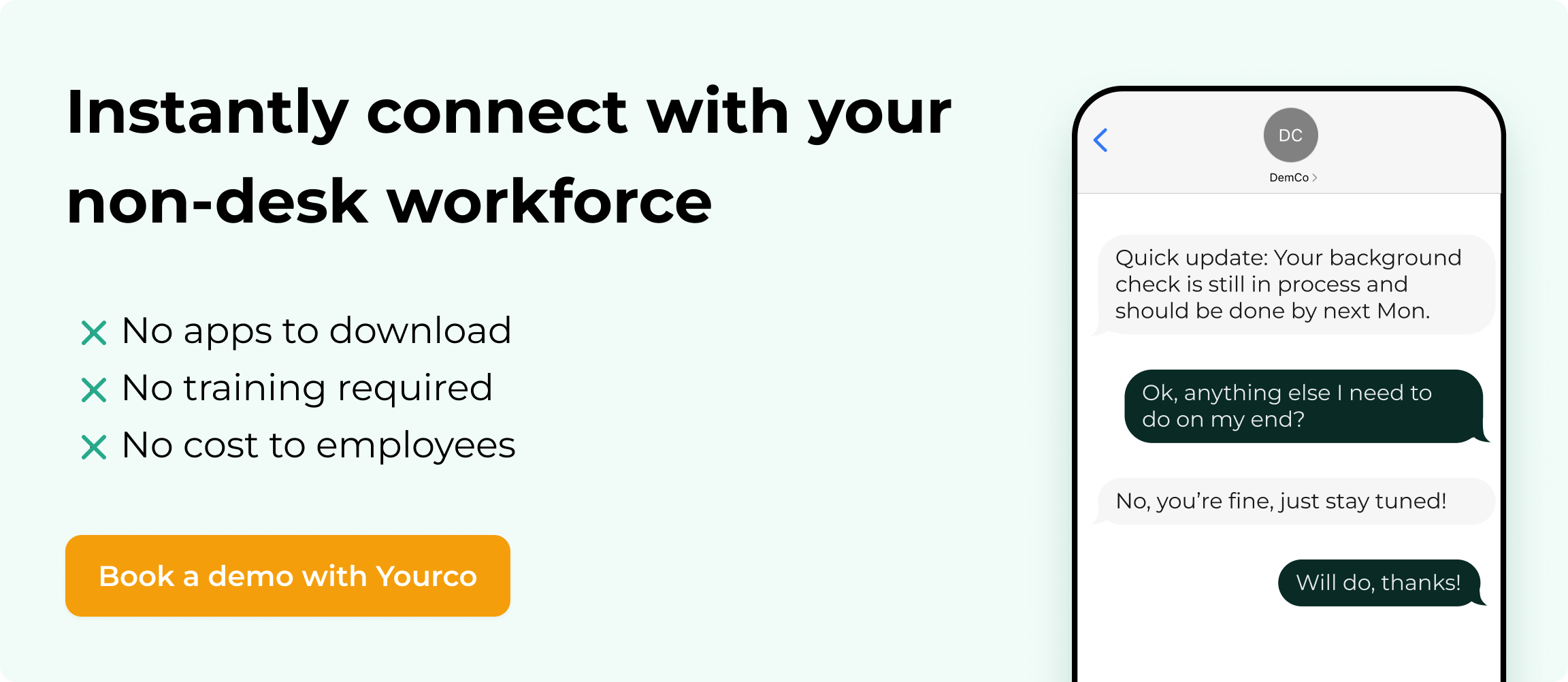Unifying Teams: The Strategic Role of Unified Communication Systems


Organizations face a significant challenge: how to effectively communicate with the 80% of the global workforce that doesn't work at a desk. Implementing unified communication systems helps connect non-desk employees—manufacturing workers, field service technicians, healthcare professionals, retail associates—who often miss important company communications.
A survey by Glean found that employees spend an average of at least two hours daily (25% of their workweek) locating necessary documents, information, or colleagues. For non-desk workers without access to traditional communication channels, this challenge intensifies, leading to mistakes, safety issues, reduced productivity, and decreased employee engagement.
The Communication Challenges of Non-Desk Workers
The Communication Challenges of Non-Desk Workers
When it comes to internal communications, non-desk workers face unique challenges that traditional office-centric approaches often fail to address. Implementing effective strategy and unified communication systems specifically tailored for these workers matters for operational efficiency and employee satisfaction. By enhancing internal communication and understanding the different types of employee communication, organizations can better meet the needs of their non-desk employees.
Industry-Specific Communication Barriers
Different industries face unique communication challenges based on their environments and operational needs. For example, implementing multilingual alert systems is important in industries with diverse workforces to overcome language barriers:
- Manufacturing: Factory floors are often noisy, making verbal communication difficult. Workers may need to wear protective equipment that limits device usage, while multiple shifts create timing challenges for company-wide communications.
- Healthcare: Frontline healthcare workers are constantly moving between patients and locations. They need instant access to information while maintaining strict patient privacy standards and following safety protocols.
- Logistics: Drivers, warehouse staff, and shipping personnel are geographically dispersed, making traditional communication methods ineffective. They need real-time updates about routes, deliveries, and inventory changes while on the move.
Why Traditional Solutions Fall Short
Several barriers prevent effective communication with non-desk workforces. To overcome these challenges, organizations must seek out solutions for bad team communication that address the specific needs of non-desk workers:
- Lack of access to traditional channels: Most non-desk workers don't have company email addresses or regular access to desktop computers, leaving them disconnected from standard company communications.
- Dispersed workforce: Workers spread across multiple locations, job sites, or on the road can't easily participate in centralized communication systems.
- Shift-based schedules: With employees working different hours around the clock, synchronous communication becomes nearly impossible, making it challenging to ensure everyone receives the same information.
- Limited time for communication: The physically demanding nature of many non-desk jobs means workers have minimal time to check messages or attend daily communications during their shifts.
- Technology barriers: Some workers may have limited familiarity with digital tools, and harsh work environments may not be conducive to using electronic devices.
- Language and literacy challenges: Diverse workforces often include employees with varying language proficiencies and literacy levels, creating additional communication hurdles.
- Safety concerns: In many environments, checking devices during work could pose serious safety risks, creating tension between staying informed and maintaining workplace safety.
Core Components of Effective Strategy and Unified Communication Systems
When developing unified communication systems for non-desk workers, certain core components ensure success. Unlike office-based employees, non-desk workers have unique communication needs that require thoughtful planning and implementation, often through the use of effective employee communication programs.
Strategic Assessment and Goal Setting
Before implementing any unified communication systems, conduct a thorough assessment of your current communication landscape and your workforce's specific needs. This strategic assessment should:
- Identify communication gaps and pain points specifically affecting your non-desk workers
- Establish clear, measurable objectives for your unified communication strategy
- Analyze the work environment and accessibility constraints (noisy workplaces, limited computer access, etc.)
- Gather input directly from workers through surveys or focus groups
This initial assessment provides the foundation for your entire strategy. Understanding how your non-desk workforce currently communicates and what barriers they face helps you develop solutions that genuinely address their needs rather than imposing technology that may not fit their work context.
Technology Selection and Integration
Once you've completed your assessment, you can make informed decisions about which technologies will best serve your workforce. For non-desk environments, certain characteristics matter:
- Mobile-first approach: Non-desk workers are constantly on the move, making it impractical to rely on traditional communication tools like email or intranet. A mobile-first strategy ensures employees receive important updates instantly, whether they’re on-site, in transit, or working remotely.
- User-friendly interfaces: Intuitive design reduces the learning curve and encourages adoption among workers who may have varying levels of tech proficiency.
- Multi-channel communication: Incorporate various channels (SMS, digital signage, etc.) to ensure information reaches all employees regardless of their location or role.
- Real-time updates: Non-desk workers need immediate access to information about safety protocols, shift changes, and urgent announcements.
Your selected technologies should integrate seamlessly with existing systems like HR management, production planning tools, or inventory management systems to create a cohesive unified communication system.
HRIS and Payroll Integration
Large enterprises often maintain multiple systems for human resources, payroll, time tracking, and other workforce management functions. When implementing a unified communication system, companies must decide whether to consolidate these systems or integrate them.
Integration considerations include:
- Employee directory synchronization: Communication platforms must accurately maintain employee data, especially in high-turnover industries. Real-time directory synchronization eliminates administrative burden and ensures messages reach the right people.
- Bridge solutions: Consider communication platforms that can connect multiple backend systems while maintaining a consistent user experience. This approach allows for gradual integration of legacy systems without disrupting communication.
- Data accuracy across systems: Information like shift schedules, time-off requests, and organizational changes should flow seamlessly between HR systems and communication platforms to ensure workers receive accurate, relevant information.
- Authorization and identity management: Integrated systems should maintain proper access controls while simplifying login processes for non-desk workers who may have limited technical experience.
The ideal solution often involves implementing a communication layer that sits atop existing systems, providing consistent messaging while backend integration progresses. This approach delivers immediate communication improvements while allowing for phased technology modernization.
Yourco is an SMS-based platform that provides just that—integrations with multiple HRIS and payroll platforms, ensuring that no matter how disconnected you are with your data, you can still ensure consistent communication.
Implementation Planning and Change Management
Even the most well-designed strategy and unified communication systems will fail without proper implementation and change management. This phase should include:
- A phased rollout plan with clear timelines and responsibilities: Gradually introducing new tools helps prevent overwhelm and ensures smooth adoption.
- Comprehensive training programs tailored to different user groups: Different roles may require customized training to maximize effectiveness.
- Champions or ambassadors within the workforce to promote adoption: Engaged employees can encourage peers, answer questions, and drive enthusiasm.
- Regular feedback mechanisms to address issues quickly: Open communication channels allow for quick adjustments and improvements.
- Leadership involvement and support: Visible commitment from management boosts employee confidence and reinforces the importance of the new system.
- Incentives and recognition programs: Acknowledging early adopters and successful usage can motivate widespread adoption.
Specialized Unified Communication Systems for Non-Desk Workforces
Generic communication tools won't suffice for non-desk teams. The unique challenges faced by non-desk workers require specialized unified communication systems designed with their specific needs in mind.
Mobile-First Communication Platforms
For non-desk workers, mobile devices are often the primary (or only) digital touchpoint with your organization. This reality necessitates a mobile-first approach to communication. Implementing communication tools for deskless workers allows organizations to reach these employees effectively:
- A mobile-first approach ensures that important updates, schedules, and announcements reach employees instantly, no matter where they are.
- Today’s workforce expects quick, intuitive communication methods that align with their everyday mobile usage.
- Mobile-first platforms, utilizing an alert notification system, can leverage push notifications to ensure urgent messages are delivered and read promptly.
The most effective mobile platforms for non-desk environments don't require company email addresses, extensive training, or even app downloads in some cases. SMS-based systems can achieve read rates as high as 98% compared to just 20% for email-based communications.
Multi-Modal Messaging Systems
Different types of information require different communication methods. Effective unified communication systems for non-desk workers offer multi-modal options that accommodate various work environments:
- SMS integration for important updates and time-sensitive information
- Visual communication tools for complex instructions or safety procedures
- Push-to-talk technologies that enable hands-free communication, especially important in environments where workers need to keep their hands free
- QR codes on physical materials that link to digital resources, bridging the gap between traditional and digital communication
For multilingual workforces, solutions that offer automatic translation capabilities ensure that language differences don't become communication barriers. This feature is particularly valuable in industries with diverse workforces where safety instructions and operational procedures must be clearly understood by everyone.
Collaborative Tools for Dispersed Teams
Non-desk teams often work across multiple locations, making collaboration particularly challenging. Specialized unified communication systems address this through:
- Knowledge repositories accessible across devices, allowing workers to access SOPs, safety protocols, and training materials from anywhere
- Visual communication tools that enable workers to share images of equipment issues or job site conditions for remote troubleshooting
- Integration with existing workforce management systems
The best unified communication systems for non-desk workers don't just replicate office-based tools in a mobile format—they're fundamentally redesigned with the unique constraints and opportunities of non-desk environments in mind. With the right specialized system, you can bridge the communication gap between your desk and non-desk employees, creating a more connected, efficient, and engaged workforce.
Building a Culture of Communication Inclusion
Creating an inclusive communication culture requires deliberate effort to ensure all worker types—especially non-desk employees—feel heard, valued, and connected to your organization. Developing systems that treat all employees equally when it comes to communication can dramatically improve engagement and retention.
Creating Communication Equality Across Worker Types
The traditional approach to workplace communication has often unintentionally created a two-tier system, where desk workers receive timely information while non-desk workers are left out of important conversations. To break down these barriers:
- Implement mobile-first unified communication systems that work for everyone, regardless of their access to company computers or email
- Ensure important information reaches all employees simultaneously, rather than trickling down to non-desk workers later
- Provide equal opportunities for non-desk workers to contribute ideas and feedback
When you prioritize communication equality, you demonstrate that every employee matters to your organization. This sense of community strengthens engagement and reduces turnover, delivering a direct benefit to your bottom line.
Empowering Two-Way Feedback Channels
Communication isn't just about pushing information to employees—it's about creating dialogue. Two-way communication channels are important for making non-desk workers feel valued and understood:
- Use polls and surveys to gather real-time employee feedback on company initiatives
- Create simple mechanisms for employees to submit questions or concerns
- Ensure leadership responds promptly to feedback, showing employees their input matters
- Schedule regular opportunities for non-desk workers to speak directly with management
Felisha Parker, VP of HR at McCarthy Auto Group, notes the impact of implementing two-way communication: "We have nearly 700 employees and 80% are non-desk based, communication is a challenge. [Our communication platform] provides a quick easy way to reach everyone within our organization and a secure way for employees to reach HR and leadership without a computer."
Fostering Knowledge Sharing Between Desk and Non-Desk Teams
When desk and non-desk employees can easily share knowledge and collaborate, the entire organization benefits from improved problem-solving and innovation. To encourage knowledge sharing:
- Create forums where employees from different roles can exchange ideas and best practices
- Highlight contributions from non-desk workers in company communications
- Involve non-desk workers in the design process when implementing new communication tools
- Use visual content like videos and images to make complex information accessible to everyone
The most successful companies understand that inclusive communication isn't just a nice-to-have—it's important for building a cohesive organization where every employee feels valued and connected to your mission.
When you invest in communication inclusion, you create a workplace where all voices are heard, knowledge flows freely between teams, and everyone has the information they need to contribute their best work.
Connect, Engage, Succeed: Your Path Forward
The communication divide between desk and non-desk workers creates significant challenges for large enterprises. The right communication tools ensure all employees remain informed regardless of their work environment.
Organizations with connected workforces outperform those where information flows unevenly. This requires tools built specifically for non-desk workers. Manufacturing requires systems that work in noisy environments. Logistics demands mobile solutions functioning across locations. Healthcare needs secure, HIPAA-compliant platforms.
Yourco addresses these challenges through SMS-based communication that requires no app downloads or company email addresses, providing a 98% read rate (compared to email's 20%). Features like translations in 135+ languages ensure inclusive communication for diverse workforces, connecting everyone to your company's mission. Additionally, with two way communication, built in polls and surveys and integration with multiple HRIS and payroll systems, Yourco fulfils all the requirements of providing a unified communication system.
Try Yourco for free today or schedule a demo and see the difference the right workplace communication solution can make in your company.



